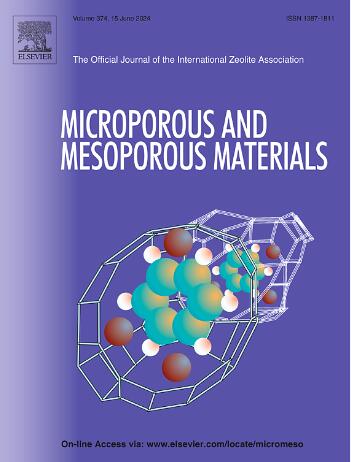The support affects the catalytic conversion in thymol hydrogenation reaction
IF 4.8
3区 材料科学
Q1 CHEMISTRY, APPLIED
引用次数: 0
Abstract
Hydrogenation of the aromatic ring in phenolic compounds is an important reaction in industry and in the synthesis of fine chemicals. Pd-supported catalysts have proved to be highly active and efficient in deep hydrogenation of aromatic ring. Previous studies confirmed that the acidity and topology properties of the support play an important role in the efficient transformation of the phenolic reactant. In this study, we have investigated the effect of these two parameters by designing advanced layered MFI and MWW zeolites. To understand the effect of acidity, we compared the catalytic performance of a series of Pd/MFI catalysts that significantly differed in the acidity of the support. Then, we compared the catalytic results from Pd on aluminosilicate MFI and Pd/MCM-56 to see the effect of the support's topology. Thymol was used as a model phenolic reactant, and the results confirmed that not only the Pd on non-acidic MFI support was inactive (conversions below 25 %), but also the acidity of the MFI support led to higher thymol conversion (47 %), while more weak acid centers and silanol groups in dealuminated MFI topped up the outcome (100 % conversion). Data also showed that between two aluminosilicate supports, the MWW outperformed MFI (100 % vs. 47 %), due to its topology and morphology for better accommodating thymol and interacting with it.

求助全文
约1分钟内获得全文
求助全文
来源期刊

Microporous and Mesoporous Materials
化学-材料科学:综合
CiteScore
10.70
自引率
5.80%
发文量
649
审稿时长
26 days
期刊介绍:
Microporous and Mesoporous Materials covers novel and significant aspects of porous solids classified as either microporous (pore size up to 2 nm) or mesoporous (pore size 2 to 50 nm). The porosity should have a specific impact on the material properties or application. Typical examples are zeolites and zeolite-like materials, pillared materials, clathrasils and clathrates, carbon molecular sieves, ordered mesoporous materials, organic/inorganic porous hybrid materials, or porous metal oxides. Both natural and synthetic porous materials are within the scope of the journal.
Topics which are particularly of interest include:
All aspects of natural microporous and mesoporous solids
The synthesis of crystalline or amorphous porous materials
The physico-chemical characterization of microporous and mesoporous solids, especially spectroscopic and microscopic
The modification of microporous and mesoporous solids, for example by ion exchange or solid-state reactions
All topics related to diffusion of mobile species in the pores of microporous and mesoporous materials
Adsorption (and other separation techniques) using microporous or mesoporous adsorbents
Catalysis by microporous and mesoporous materials
Host/guest interactions
Theoretical chemistry and modelling of host/guest interactions
All topics related to the application of microporous and mesoporous materials in industrial catalysis, separation technology, environmental protection, electrochemistry, membranes, sensors, optical devices, etc.
 求助内容:
求助内容: 应助结果提醒方式:
应助结果提醒方式:


